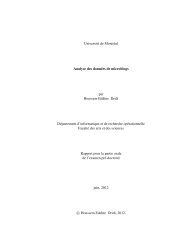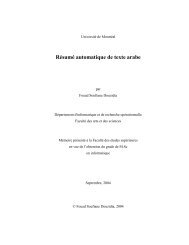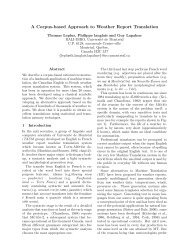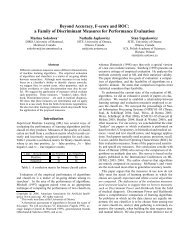Designing a Machine Translation System for Canadian Weather ...
Designing a Machine Translation System for Canadian Weather ...
Designing a Machine Translation System for Canadian Weather ...
Create successful ePaper yourself
Turn your PDF publications into a flip-book with our unique Google optimized e-Paper software.
<strong>Designing</strong> a <strong>Weather</strong> Warning <strong>Translation</strong> <strong>System</strong> 4<br />
Fig. 1. A sample weather warning as it appeared on Environment Canada’s website in<br />
November 2011.<br />
Fig. 1 shows an example of a strong wind warning issued on 22 November 2011, as<br />
it appeared on EC’s website. A short header identifies the affected area, followed by<br />
a discussion explaining the threat. A French version of every warning is available, in<br />
the same <strong>for</strong>mat. That version is accessed by clicking on the “Français” link in the<br />
upper left corner of the page. There are different kinds of warnings, depending on<br />
the threat reported. For instance, WU bulletins describe severe thunderstorms, WF<br />
bulletins warn about the <strong>for</strong>mation of tornadoes, and WW bulletins are “omnibus”<br />
bulletins most often compiling warnings currently in effect.<br />
3.2 Lifecycle of Warnings<br />
The broadcast of the warning shown in Fig. 1 is in fact one of the end results of<br />
an intricate dissemination system. First, a warning is composed by a meteorologist,<br />
based on the available weather data <strong>for</strong> a specific region. The warning is issued<br />
from one of numerous emitting stations spread over Canada, and is written in English,<br />
except when it originates from the French-speaking province of Quebec. The











